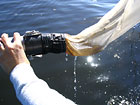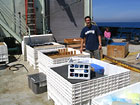

 | |||||||||||||||||
|
|
Journals 2005/2006Denis Costello
July 26, 2005 Even though this was our last day at sea, the University of Washington group and the NOAA team continued to sample from the CTD and plankton net tows. They wanted to continue sampling for PN. For the rest of the groups, today served as a day to break down equipment and instruments and pack them for transit back to the UW dock. We reached the EH2 mooring off the Washington shelf after breakfast. A seal was relaxing on the mooring, taking in the warm sunlight.
The sea was calm but the water color had changed significantly. It had changed to thick brown color. Brady Olson (UW) remarked that it was probably due to a large presence of diatoms called Chaetoceras. Sheryl sampled the water with her plankton net and quickly observed the water under the microscope. Brady, Mike and Stacey (UW) also placed their sample into their FlowCAM instrument. After careful analysis, all involved concluded that we had sampled a bloom of Chaetoceras with some Pseudo-nitzschia. This caused excitement among the science party because this finding suggests the upwelling had brought up enough nutrients to start a bloom in the Juan de Fuca eddy. As a result of this event, it might be expected that Pseudo-nitzschia might begin to bloom after our cruise. In the big scheme of things, this day's discovery brought hope that the ecosystem in the Pacific Northwest is not dead. Contrary to what had been written earlier in the San Francisco Chronicle and the Seattle Times, the local ecosystem has been given a reprieve. The winds had returned in time to cause the upwelling necessary to supply nutrients to the surface, allowing the ecosystem to continue its course. I'm sure that I'll see our results in publications after our cruise.
We then continued to break down our workstations. All of our stuff was to be packed away in large white containers on the back deck of the ship. This was tricky because we had to carry our belongings along the starboard side of the ship, around the smaller watercraft and place them into their respective containers. We had to first remove the straps used to secure the containers and move them into a position for loading. This exposed the eyebolts on the deck, which is a hazard when trying to walk along a rolling ship. We removed most of the eyebolts and proceeded to load each of twelve containers. The incubators were also broken down and loaded into their boxes. Prior to packing them, we had to wash each incubator with fresh water and allow time to dry. After lunch, I read the last set of chlorophyll samples on the fluorometer. That was a small victory in itself. Knowing that the last of the samples have been read meant that I could put away the rest of the logbooks, sampling equipment, acids and acetone. Sean and Caroline spent a good part of the day loading up the polycarbonate sample bottles. Each bottle had to be rinsed with acid and Milli-Q water and then given another shot of hydrochloric acid for long-term storage. This will kill off any bacteria or other microbes that might otherwise accumulate in the bottles. Since the labs were being broken down, they had to perform the task out on the back deck. When they were finished, the packs of bottles were secured for the night. It was hard to believe that were set up to conduct science at the start of the day and completely broken down by the end of the day. The only items still left to be packed are the laptop computers and camera equipment. As the sun was setting, most of the science crew gathered on the back deck to celebrate a good cruise. With all of the equipment being secured, we were able to relax knowing that when we woke up the next day, all that was left to do was to off-load the ship.
|
||||||||||||||||



